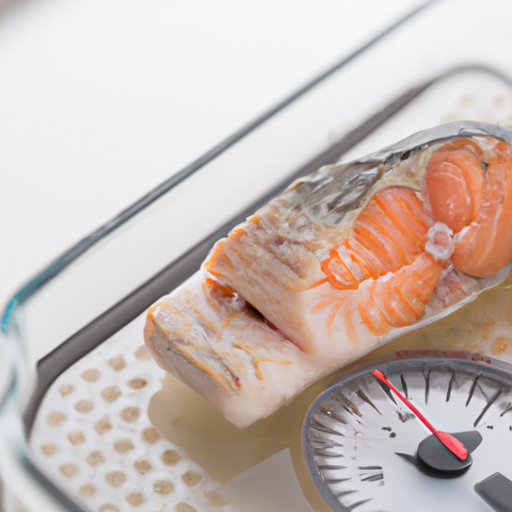
Introduction to the Problem of Determining When Salmon is Done Cooking
Cooking salmon is a common issue for home chefs, but it can be challenging to determine when salmon is done cooking. Eating undercooked salmon can cause food poisoning, which can lead to severe illness. Therefore, it’s essential to know the proper way to cook salmon. This article will provide easy and safe ways to tell when salmon is fully cooked.
Using a Thermometer
The easiest and most reliable way to determine when a salmon is fully cooked is to use a thermometer. A thermometer helps you measure the internal temperature of the fish, which can be a great indicator of doneness.
Proper thermometer placement is essential for getting an accurate reading. You should insert the thermometer into the thickest part of the salmon, making sure that it doesn’t touch the bone. For salmon, the ideal temperature for cooked salmon is between 145-150°F (63-65°C). There are several types of thermometers to choose from, including instant-read, digital probe, and oven-safe thermometers.
Checking Color and Texture
Another way to tell if salmon is cooked is by looking at its color and texture. Once salmon is cooked, it should have a firm texture, and the color should change to opaque. Depending on the type of salmon, the color and texture may differ. Coho salmon, for example, has a brighter orange color than Atlantic salmon.
Testing with a Fork
Testing salmon with a fork is one of the most common methods used to determine doneness. To test with a fork, probe the thickest part of the salmon and gently twist the fork. Fully cooked salmon should flake easily and remain moist. However, this method can be unreliable, as salmon can appear cooked on the outside but remain undercooked on the inside.
Looking for White Protein
Another way to tell if salmon is cooked is by checking for white protein seepage. If the salmon is fully cooked, a small amount of white protein should appear on the surface. You must avoid overcooking salmon as it can lead to excessive protein seepage, resulting in a dry, tough texture.
Checking Internal Temperature
Using a thermometer to check the internal temperature of salmon is the most reliable way to tell when it is cooked. Before testing, let the salmon rest for a few minutes as the temperature may rise slightly during resting. To take the temperature, insert the thermometer into the thickest part of the salmon, and make sure it reaches the center. The temperature should reach around 145°F (63°C).
Testing the Center with a Gentle Press
You can also test salmon for doneness by pressing the center gently with a finger. If the salmon feels firm and bounces back, then it’s likely fully cooked. However, if it still feels soft and spongy, you may need to cook it for a few more minutes.
Observing Juices
If you notice clear juices starting to seep out of the salmon, it’s likely that it’s overcooked. If you see any milky or opaque juices, that’s a sign of undercooked fish. Ideally, the salmon should have slightly pink color juices with no hint of greyness.
Conclusion and Recap
There are many easy and safe ways to determine when salmon is fully cooked. A thermometer is the most reliable way to ensure that salmon is completely cooked. However, observing color, texture, testing with a fork, checking for white protein, internal temperature, testing center using gentle pressure, and observing juices are some other useful techniques. Whichever method you choose, we hope that this article has been helpful to ensure you cook salmon in the safest and most delicious way possible.
Finally, let us not forget the importance of cooking salmon thoroughly, as undercooked salmon can be dangerous for our health. Make sure you follow safe cooking methods and avoid overcooking or undercooking salmon.





